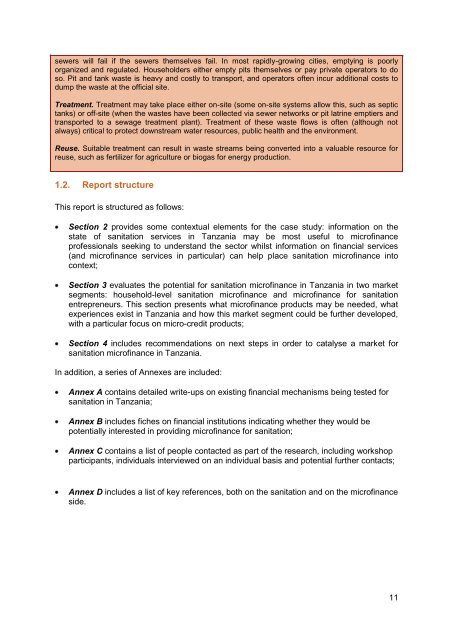REPORT__Evaluating_the_potential_of_microfinance_for_sanitation_in_Tanzania_May_2013
REPORT__Evaluating_the_potential_of_microfinance_for_sanitation_in_Tanzania_May_2013
REPORT__Evaluating_the_potential_of_microfinance_for_sanitation_in_Tanzania_May_2013
Create successful ePaper yourself
Turn your PDF publications into a flip-book with our unique Google optimized e-Paper software.
sewers will fail if <strong>the</strong> sewers <strong>the</strong>mselves fail. In most rapidly-grow<strong>in</strong>g cities, empty<strong>in</strong>g is poorly<br />
organized and regulated. Householders ei<strong>the</strong>r empty pits <strong>the</strong>mselves or pay private operators to do<br />
so. Pit and tank waste is heavy and costly to transport, and operators <strong>of</strong>ten <strong>in</strong>cur additional costs to<br />
dump <strong>the</strong> waste at <strong>the</strong> <strong>of</strong>ficial site.<br />
Treatment. Treatment may take place ei<strong>the</strong>r on-site (some on-site systems allow this, such as septic<br />
tanks) or <strong>of</strong>f-site (when <strong>the</strong> wastes have been collected via sewer networks or pit latr<strong>in</strong>e emptiers and<br />
transported to a sewage treatment plant). Treatment <strong>of</strong> <strong>the</strong>se waste flows is <strong>of</strong>ten (although not<br />
always) critical to protect downstream water resources, public health and <strong>the</strong> environment.<br />
Reuse. Suitable treatment can result <strong>in</strong> waste streams be<strong>in</strong>g converted <strong>in</strong>to a valuable resource <strong>for</strong><br />
reuse, such as fertilizer <strong>for</strong> agriculture or biogas <strong>for</strong> energy production.<br />
1.2. Report structure<br />
This report is structured as follows:<br />
Section 2 provides some contextual elements <strong>for</strong> <strong>the</strong> case study: <strong>in</strong><strong>for</strong>mation on <strong>the</strong><br />
state <strong>of</strong> <strong>sanitation</strong> services <strong>in</strong> <strong>Tanzania</strong> may be most useful to micr<strong>of</strong><strong>in</strong>ance<br />
pr<strong>of</strong>essionals seek<strong>in</strong>g to understand <strong>the</strong> sector whilst <strong>in</strong><strong>for</strong>mation on f<strong>in</strong>ancial services<br />
(and micr<strong>of</strong><strong>in</strong>ance services <strong>in</strong> particular) can help place <strong>sanitation</strong> micr<strong>of</strong><strong>in</strong>ance <strong>in</strong>to<br />
context;<br />
Section 3 evaluates <strong>the</strong> <strong>potential</strong> <strong>for</strong> <strong>sanitation</strong> micr<strong>of</strong><strong>in</strong>ance <strong>in</strong> <strong>Tanzania</strong> <strong>in</strong> two market<br />
segments: household-level <strong>sanitation</strong> micr<strong>of</strong><strong>in</strong>ance and micr<strong>of</strong><strong>in</strong>ance <strong>for</strong> <strong>sanitation</strong><br />
entrepreneurs. This section presents what micr<strong>of</strong><strong>in</strong>ance products may be needed, what<br />
experiences exist <strong>in</strong> <strong>Tanzania</strong> and how this market segment could be fur<strong>the</strong>r developed,<br />
with a particular focus on micro-credit products;<br />
Section 4 <strong>in</strong>cludes recommendations on next steps <strong>in</strong> order to catalyse a market <strong>for</strong><br />
<strong>sanitation</strong> micr<strong>of</strong><strong>in</strong>ance <strong>in</strong> <strong>Tanzania</strong>.<br />
In addition, a series <strong>of</strong> Annexes are <strong>in</strong>cluded:<br />
Annex A conta<strong>in</strong>s detailed write-ups on exist<strong>in</strong>g f<strong>in</strong>ancial mechanisms be<strong>in</strong>g tested <strong>for</strong><br />
<strong>sanitation</strong> <strong>in</strong> <strong>Tanzania</strong>;<br />
Annex B <strong>in</strong>cludes fiches on f<strong>in</strong>ancial <strong>in</strong>stitutions <strong>in</strong>dicat<strong>in</strong>g whe<strong>the</strong>r <strong>the</strong>y would be<br />
<strong>potential</strong>ly <strong>in</strong>terested <strong>in</strong> provid<strong>in</strong>g micr<strong>of</strong><strong>in</strong>ance <strong>for</strong> <strong>sanitation</strong>;<br />
Annex C conta<strong>in</strong>s a list <strong>of</strong> people contacted as part <strong>of</strong> <strong>the</strong> research, <strong>in</strong>clud<strong>in</strong>g workshop<br />
participants, <strong>in</strong>dividuals <strong>in</strong>terviewed on an <strong>in</strong>dividual basis and <strong>potential</strong> fur<strong>the</strong>r contacts;<br />
Annex D <strong>in</strong>cludes a list <strong>of</strong> key references, both on <strong>the</strong> <strong>sanitation</strong> and on <strong>the</strong> micr<strong>of</strong><strong>in</strong>ance<br />
side.<br />
11


